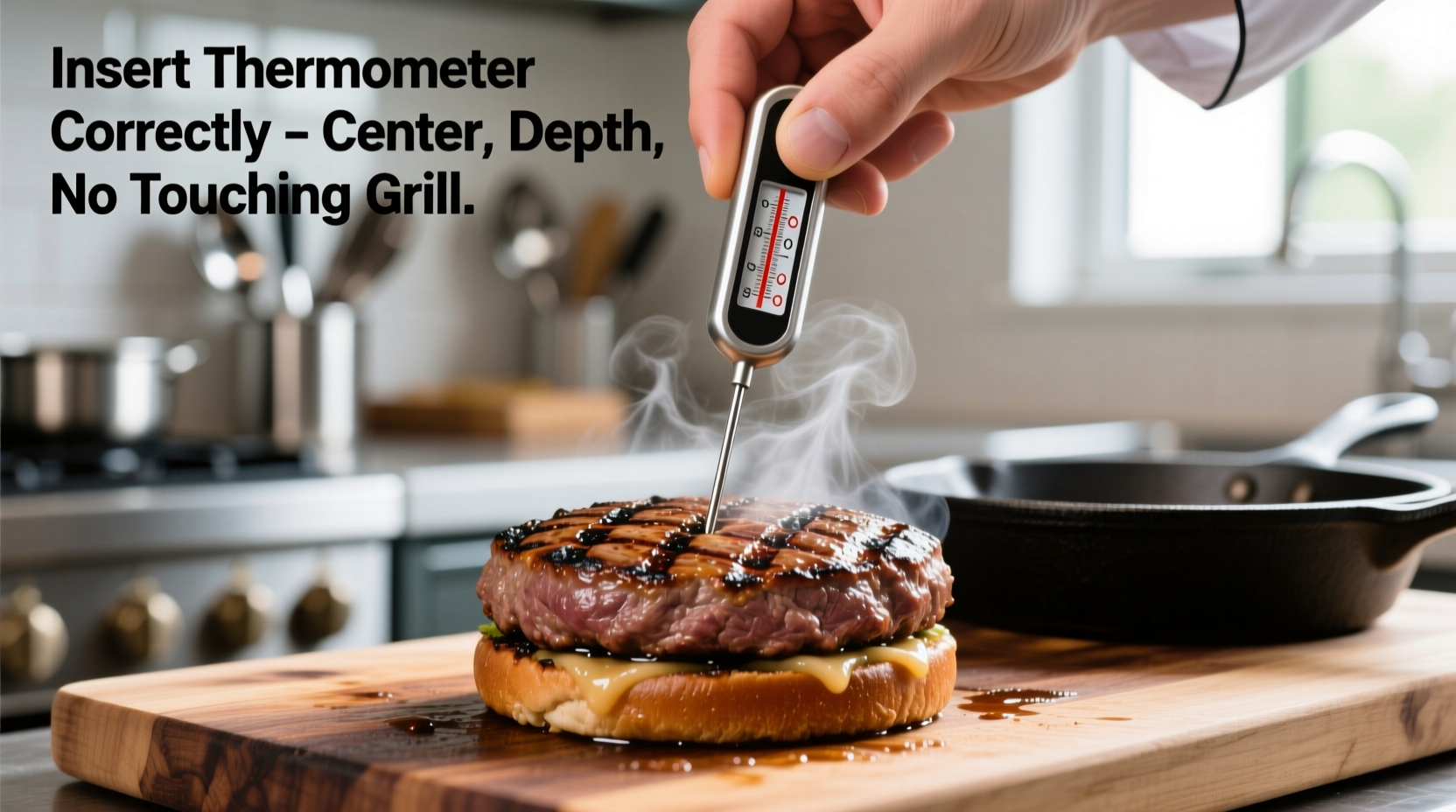Ever cut into a burger only to find it gray throughout or dangerously pink in the center? Getting the temperature right transforms your burgers from risky to restaurant-quality. This guide reveals exactly what temperature to cook burgers for safety without sacrificing flavor, backed by food science and culinary expertise.
Why Burger Temperature Matters More Than Timing
Forget counting minutes—your burger's internal temperature is the only reliable indicator of doneness and safety. Unlike steaks where surface bacteria are easily killed, ground beef burgers distribute potential pathogens throughout the meat. That's why the USDA mandates 160°F as the minimum safe temperature for ground beef products.
| Doneness Level | Internal Temperature | Visual Characteristics | Food Safety Status |
|---|---|---|---|
| Raw | Below 115°F | Purple-red throughout | Unsafe - High risk |
| Rare | 115-125°F | Bright red center | Unsafe for ground beef |
| Medium Rare | 130-135°F | Warm red center | Unsafe for ground beef |
| Medium | 140-145°F | Pink center | Unsafe for ground beef |
| Medium Well | 150-155°F | Small amount of pink | Risk remains |
| Well Done | 160°F | Brown throughout | Safe |
The Science Behind the 160°F Standard
Ground beef requires higher temperatures than whole cuts because grinding distributes surface bacteria throughout the meat. At 160°F, E. coli and other pathogens are destroyed within seconds. The Centers for Disease Control and Prevention confirms this temperature eliminates foodborne illness risks while preserving acceptable texture.
"Many home cooks mistakenly apply steak temperature rules to burgers," explains Antonio Rodriguez, culinary expert with Michelin-starred kitchen experience. "With ground beef, there's no margin for error—pathogens aren't just on the surface. Your thermometer is your essential safety tool."
How to Measure Burger Temperature Correctly
Even with the right target temperature, improper measurement leads to mistakes. Follow these professional techniques:
- Use an instant-read thermometer: Digital thermometers provide accurate readings in 2-3 seconds
- Insert horizontally: Slide the probe sideways into the burger's center, not from the top
- Check multiple spots: Ground meat heats unevenly—test several areas
- Wait for stabilization: Keep the thermometer in place until the reading stops climbing
- Remove at 155°F: Temperature will rise 5°F during resting (carryover cooking)

Achieving Juicy Burgers at Safe Temperatures
The biggest concern home cooks express is dryness at 160°F. These science-backed techniques maintain moisture:
- Don't overwork the meat: Handle ground beef minimally when forming patties
- Create a dimple: Press center slightly thinner to prevent burger doming
- Avoid pressing with spatula: Squeezes out precious juices during cooking
- Rest for 5 minutes: Allows juices to redistribute before serving
- Choose proper fat content: 80/20 lean-to-fat ratio provides optimal moisture
Special Considerations for Different Burger Types
While 160°F applies to standard beef burgers, other proteins have different requirements:
- Turkey/chicken burgers: Require 165°F due to salmonella risk
- Veggie burgers: No specific temperature needed, but should reach 165°F for food safety if containing eggs or dairy
- Commercial pre-made patties: Often contain preservatives allowing lower temperatures (check packaging)
- Restaurant settings: Some establishments serve burgers at 145°F with consumer advisories, but this carries inherent risk
Immunocompromised individuals, pregnant women, and young children should strictly adhere to the 160°F standard for beef burgers. The FDA Food Code specifically identifies ground beef as a potentially hazardous food requiring strict temperature control.
Common Temperature Mistakes to Avoid
Even experienced cooks make these critical errors:
- Relying on color: Burgers can brown before reaching safe temperatures
- Testing too early: Opening the grill frequently lowers cooking temperature
- Using oven thermometers: Not designed for thin burger patties
- Ignoring carryover cooking: Removing burgers at exactly 160°F results in overcooking
- Not calibrating thermometers: Test in ice water (32°F) or boiling water (212°F) regularly
Temperature Timeline: How Burger Safety Standards Evolved
Burger cooking recommendations have changed significantly as food science advanced:
- Pre-1990s: Many cookbooks recommended cooking burgers to 140-150°F
- 1993 E. coli outbreak: Jack in the Box incident led to major safety reassessment
- 1997: USDA officially established 160°F as minimum safe temperature
- 2011: Introduction of digital instant-read thermometers made precise measurement accessible
- Present: 160°F remains the gold standard despite ongoing debates about lower temperatures
"The 1993 outbreak was a turning point in food safety awareness," notes Rodriguez. "What we learned then still protects consumers today. Modern testing confirms 160°F remains the only reliably safe temperature for ground beef."
Your Perfect Burger Temperature Checklist
Follow this sequence for consistently perfect, safe burgers:
- Preheat grill or pan to medium-high (375-400°F)
- Form ¾-inch thick patties with center dimple
- Cook undisturbed for 3-4 minutes per side
- Insert thermometer horizontally when burgers appear mostly cooked
- Remove at 155°F (will reach 160°F during rest)
- Rest covered for 5 minutes before serving
Frequently Asked Questions
Q: Can I cook burgers to 150°F if I use fresh, high-quality beef?
A: No. Even premium ground beef carries bacterial risks throughout the meat. The USDA maintains 160°F as the only safe temperature regardless of beef quality.
Q: Why do restaurants sometimes serve pink burgers at 150°F?
A: Many establishments provide consumer advisories for medium-rare burgers, acknowledging the inherent risk. Home cooks lack commercial food safety systems and should follow the 160°F standard.
Q: How long after reaching 160°F should I let burgers rest?
A: Rest burgers for 5 minutes minimum. This allows juices to redistribute while carryover cooking completes the process. Cover loosely with foil to retain heat.
Q: Does adding Worcestershire sauce lower the safe temperature?
A: No. While acidic ingredients can slightly affect bacterial growth, they don't eliminate pathogens. Always cook to 160°F regardless of added ingredients.











 浙公网安备
33010002000092号
浙公网安备
33010002000092号 浙B2-20120091-4
浙B2-20120091-4